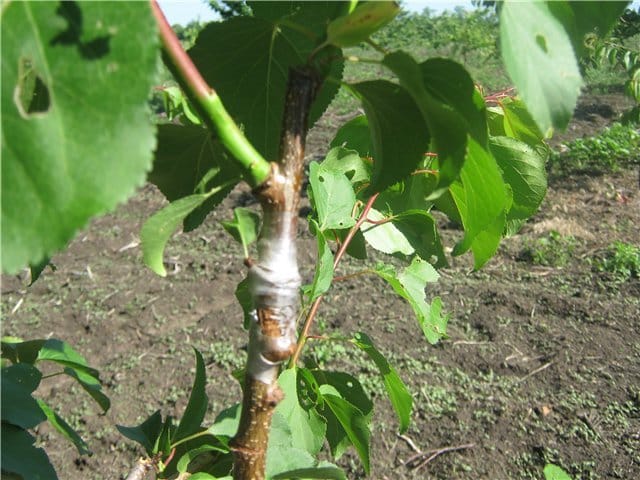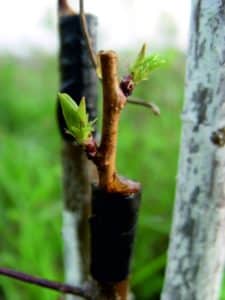How to properly vaccinate an apricot in the summer with your own hands
Apricot grafting is the easiest and most effective way to propagate it. Of course, a tree can be grown from a seed, but in this case the chances are high that instead of a cultivated variety you will get a wild one. Own-rooted plants (grown by cuttings) have low resistance to negative environmental factors, diseases and pests.
To obtain a strong, hardy varietal plant, grafting is used. The varietal scion is grafted onto a young rootstock grown from the seed, an adult apricot tree or other crops suitable for the procedure. Most gardeners prefer to graft apricots in the summer - during this period the chances that the tissues will grow together increase.
Features of summer apricot grafting

Grafting is the process of growing one part of a plant (scion) to another (rootstock). During the grafting process, tissues grow together into one whole. A grafted tree has the properties of all its parts.
Apricot can be grafted in spring, summer, autumn and even winter. However, the last two methods are suitable for the southern regions and do not always give results.
Many gardeners believe that successful apricot grafting, regardless of the region, can only be done in the spring. However, as experience shows, summer vaccinations take root just as well. The main thing is to choose the appropriate timing and carry out the work correctly.
Goals
Often, novice gardeners are afraid to graft apricots, considering this procedure too complicated. In fact, vaccination can solve several problems:
- Space saving. If there is not enough space in the garden to grow a large number of fruit trees, grafting will solve the problem. With its help, from one tree it will be possible to obtain fruits not only of different varieties of apricots, but also of some other stone fruit crops.
- Formation of a beautiful crown. The direction of growth of grafts is easily regulated. Several grafted branches will set the direction of the crown and facilitate the formation process.
- Aesthetic appearance. Grafting allows you to combine several crops: peaches, apricots of different varieties, damsons, cherry plums, plums. Plants strewn with fruits of different colors and sizes look unusual and beautiful.
- Second life for trees. If the plant is strong enough, but produces poor or tasteless harvests, it is not necessary to uproot it and replace it with another variety. It will become a high-quality scion.
- Increased endurance. Frost-resistant, hardy plants with high immunity are usually chosen as a scion. These qualities are also transmitted to the scion. Thanks to this, in our country it is possible to grow varieties that do not have such characteristics.
- Improving the taste of fruits. Grafting a branch of sweet varietal apricots onto wild and semi-cultivated varieties will improve the taste characteristics of the fruit.
- Acceleration of fruiting. Grafted branches begin to bear fruit within 1-2 years after tissue germination. This is much faster than when propagating a plant from cuttings or seeds.
Basic Rules
Even a novice gardener can cope with apricot grafting, but the complexity of the work should not be underestimated either.
It is important to act carefully and follow the basic rules:
- Sharp instrument. It is important that the tool used for grafting is well sharpened. With a dull knife or pruning shears, it will not be possible to achieve a perfectly even cut, and the junction of the rootstock and scion will not be tight. This will reduce the chances of proper tissue fusion.

- Disinfection. If fungi or bacteria are introduced into the graft, the tissue will begin to rot and will not grow together. The risk of infection of the entire tree will increase. To avoid problems, the instrument is disinfected with a dark pink solution of potassium permanganate, copper sulfate or alcohol. It is also recommended to disinfect the scion by dipping it in a light pink solution of potassium permanganate.
- No direct sunlight. Vaccination work is carried out on cloudy days early in the morning or in the evening. During times of high sun activity, the likelihood that the branch will take root decreases.
- Tight connection. The cut of the scion must exactly coincide with the cut of the rootstock. It is important to connect the parts as tightly as possible, securely taping them with electrical tape.
- Sterility. You need to work with clean, sanitized hands, preferably wearing gloves. You cannot touch the slices.
- High-quality grafting material. The scion and rootstock must have the correct shape. The absence of damage, stains, cracks in the bark and other signs of diseases and pests is important.
- Operation speed. During summer grafting, the rootstock and scion are connected immediately after cutting. The more time passes between harvesting and grafting, the less chance the procedure will be successful.
- Protection from direct sunlight. The vaccination site is shaded.
- Treatment. After grafting, the open sections of the cuts on the rootstock are covered with garden pitch.
Advantages and disadvantages of summer vaccination
Many gardeners choose summer rather than spring for grafting work. This is due to the benefits of summer vaccination:
- With summer grafting, the sections grow together in just one year. The plant easily survives wintering.
- The risks of overexposure to the rootstock are minimal, since it is grafted immediately after cutting.
- If the grafted branch dies, the gardener will have time to repeat the procedure.
- In summer, you can use all the cuttings that were selected for the rootstock.
- In summer, the most active growth of callus is observed. Thanks to this, the junction of the scion and the rootstock is strong and inconspicuous.
- Spring scions rot more often than summer scions.
Summer vaccination also has disadvantages:
- It will not be possible to prepare vaccination material in advance. The rootstock and scion are connected after cutting.
- Summer budding does not take root as well as in spring. In summer it is better to use whole cuttings rather than buds. In this case, more grafting material will be needed.
Deadlines
Summer grafting is carried out in early June, when flowering is already completed, but the weather is not hot outside, or from mid-July to mid-August, during the second sap flow.
During these periods, the plant actively grows tissue, which contributes to the rapid fusion of sections.
Selection and preparation of grafting material
For the vaccination to be successful, it is important to properly prepare the material. Attention is paid to both the scion and the rootstock.
Rootstock
Apricot is grafted onto a tree no more than 7-10 years old. Old trees grow less well with the tissues of young branches, so most grafts die. Even if the grafting procedure on an old plant is successful, the yield of such a plant will remain low.
It is also not recommended to graft apricot onto trees that are too young. Here the probability of tissue fusion is also low. The optimal age of a rootstock tree is 3-5 years.
When choosing a rootstock, attention is paid both to the condition of the entire tree and directly to the part on which the cut will be made. The selected plant must be resistant to negative environmental factors and have high immunity.
It is important that there are no compactions, foreign formations, cracks in the bark, spots on the leaves, or other signs of infection and pests.
Select zoned rootstock varieties for each area. The root system must be strong and well developed.
Dark brown branches are not recommended for grafting. This color is a sign of frostbite.
Note! Wild trees are considered the best scions. You can grow them yourself from seeds.
If an apricot is grafted onto a trunk, then the plant is cut at a distance of 5-20 cm from the ground surface. When grafting onto skeletal branches, the cut is made at a distance of 10-50 cm from the trunk. The thin part of the branch cannot be used as a rootstock, because In this case, the shoot will not take root and will quickly break from the wind or under the weight of the fruit.
All leaves are removed from the rootstock. The cut area is cleaned with sandpaper.
Scion
In summer, grafting is done with fresh cuttings, that is, the scion is used immediately after cutting. The longer the branches are stored, the less likely they are to take root.
The grafting material is taken from healthy, productive trees with high-quality fruits. The branches must be of the correct shape.
To carry out summer grafting work, take green one-year-old shoots, the diameter of which is at least 1.5 cm.There should be a growth bud at the top, and leafy buds on the sides. Preference is given to the upper shoots, which are well illuminated by the sun.
Step back 30 cm from the top and make a cut with a sharp pruner or knife at an angle of 45°. Cut cuttings are placed in water or a growth stimulator. Some gardeners recommend dipping the grafting material into a light pink solution of potassium permanganate.
The leaves are removed from the cuttings, but the buds are left. This is necessary to ensure that moisture does not evaporate through the sheet plates.
Important! Cuttings are carried out in the morning or afternoon in cloudy but not rainy weather.
How to graft an apricot correctly
In order for the branch to take root, it is important to choose the right plant for grafting. Remember that stone fruits are grafted onto stone fruits, and pome fruits are grafted onto pome fruits.
For apricot
Apricot branches are best grafted onto apricots. The cuttings quickly take root and the tissues grow together easily.
Typically, cultivated varieties of large apricots are grown with frost-resistant varieties to obtain large, tasty fruits in the climate of the central regions. They use both regionalized varieties and hardy wild game grown from seeds.
To other trees
Apricot is not only grafted onto apricot; other trees related to the crop are also suitable.
The list shows the most common options:
- Plum. It is considered the best option for apricot grafting, as it has greater frost resistance. It is recommended to choose wild or semi-wild varieties as a rootstock.
- Cherry plum. It has even greater frost resistance than plum. Easily grows with apricot. With this tandem, the fruits are especially large and juicy.
- Turn. The cultivated variety of the plant used is damson.There are no problems with the fusion of tissues, but the thorn throws out a lot of shoots, which draws strength from the plant. It will have to be permanently removed.
- Cherry. When grafting an apricot directly onto a plum tree, there is little chance of the branch surviving. Even if the procedure is successful, the grafted part will need support. It is much more effective to graft an apricot onto a plum or cherry plum branch that was previously grafted onto a cherry.
- Peach. It is much less hardy than apricot, so it is not advisable to vaccinate it. Usually apricot acts as a rootstock for peach. However, in the southern regions such experiments are possible.
Step-by-step instructions for vaccination
The effectiveness of vaccination work depends on the correctness of its implementation. It is necessary to take into account all the nuances.
Required materials and tools
To carry out grafting work you will not need many tools:
- pruning shears for cutting green shoots;
- hacksaw for preparing scion;
- a sharp garden or painting knife to give the cut areas the desired shape;
- electrical tape or special garden tape to secure the connection point;
- film or bag;
- garden pitch or other means for processing cuttings;
- sandpaper for cleaning cuts of the rootstock;
- a flat-head screwdriver for creating a hole when grafting into a cleft.
Different methods of vaccination
There are five main methods of vaccination. Each of them has its own nuances. The choice depends on the preference of the gardener.
Into the cleft
Many gardeners believe that it is easiest to graft an apricot into a split. This method is suitable even if the diameter of the rootstock is significantly larger than the scion.
Split technique:
- The lower end of the cutting is cut on both sides to a height of 2-5 cm so that a thin wedge is obtained.
- A split is made in the rootstock, the depth of which is equal to or slightly greater than the wedge on the scion. Depending on the thickness of the rootstock, use a knife, hatchet or screwdriver.
- Cuttings are inserted into the split so that the bark and its layers on the scion and rootstock coincide on at least one side. If the scion has a large diameter, then several cuttings can be inserted into it.
- The junction is tightly wrapped with garden tape or electrical tape and treated with garden varnish.
For the bark
Apricot is grafted onto the bark if the cuttings are much thinner than the rootstock.
The technique is as follows:
- The lower part of several cuttings is cut with a transverse wedge. The thicker the rootstock, the more scions are taken.
- A transverse cut is made on the bark no deeper than 5 cm.
- The shutters of the incision are moved apart. The cuttings are inserted into the resulting pocket so that the place where they are cut fits tightly to the bark.
- The resulting structure is wrapped with electrical tape. Garden pitch is used for coating.
Budding
Summer budding involves the use of a bud. Usually the procedure is carried out at the end of the summer period.
Summer budding instructions:
- A bud is selected from the central part of an annual green branch. Leaves are plucked off it. Then they cut it off along with a 1.5-2 cm section of bark. While preparing the scion, the eye is wrapped in gauze.
- A T-shaped incision is made on the bark of the rootstock (preferably in the area with the bud).
- The bark is carefully pulled apart. A kidney is inserted under it.
- The bark flaps are closed so that only the bud remains outside.
- The junction of the scion and the rootstock is wrapped with electrical tape so that the bud remains uncovered.
Copulation
Copulation is used if the rootstock and scion have the same diameter.
The copying instructions are as follows:
- The lower part of the scion and the cut of the rootstock are cut at an oblique angle. The length of the sections is 3-4 cm. The dimensions of both sections must completely match.
- The cutting is applied to the cut of the rootstock so that they completely coincide and fit tightly to each other.
- The junction is tightly wrapped. The upper cut is covered with garden varnish.
Bridge
The method is used to save trees whose bark has been damaged due to frost or animals.
Bridge grafting is especially suitable for trees whose bark has been removed in a circle.
Bridge grafting:
- Choose a place where there is not enough bark ring. The edges of the bark on both sides are trimmed evenly. The exposed area is wiped with a clean cloth. Vertical cuts are made on the upper part of the bark according to the number of cuttings. Opposite the upper cuts, the bark is cut in the lower part.
- The cuttings are sharpened with a wedge on both sides. One side of the cutting is inserted into the lower cut on the bark and secured with electrical tape. The cuttings are bent into a bridge and their second cut is inserted into the upper cut in the bark.
- The grafting area is treated with garden varnish.
Apricot care after grafting
After grafting, the cuttings are shaded so that they do not burn when exposed to direct sunlight. The tree is watered as the soil dries.
If shoots form on the tree below the cutting, it is removed. Otherwise, the grafted branch will not have enough strength.
2 weeks after buds appear on the grafted part, the tape is removed. If the cutting blooms in the first year, then all the inflorescences are cut off so that they do not drain the strength from it.
Tips on the topic
A few tips will help make the vaccination procedure easier and achieve better results:
- It is recommended to attach the electrical tape with the adhesive layer facing out.This will help avoid damaging the connection when removing the winding.
- Var hardens and is difficult to apply in cold weather. It leaves greasy stains on clothes, so many gardeners replace it with whitewash, which does not have such disadvantages.
- For beginners, it is convenient to use a grafting gun, which allows you to make perfect cuts. The more accurately the cut is made, the higher the chances of survival.
- If the harness is left for more than a year, the connection will be damaged.
- It is desirable that the ripening time of all varieties grafted onto a tree coincide.
Conclusion
Apricot grafting will increase the plant's endurance and immunity, and improve the quality and quantity of the harvest. Experienced gardeners recommend doing this procedure without fail.
Summer is considered a good time for grafting. During this period, the tissues quickly grow together and the new branch has time to take root and grow stronger before frost.